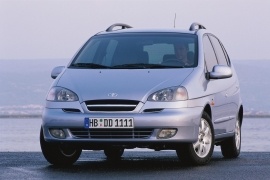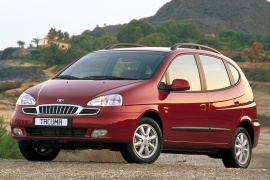DAEWOO Tacuma Models/Series Timeline, Specifications & Photos
First production year: 2000
Engines: Gasoline
Body style: Van
Daewoo couldn't convince too many European customers with its compact-sized minivan Tacuma (called Rezzo in Korea), but it still had to update it if it wanted to keep it on the market.
After four years since it launched this MPV, Daewoo introduced a facelifted version of the vehicle, trying to keep it on the market. Yet, it was more of a life-support than a life-savior solution. The Pininfarina-designed minivan was, indeed, improved, but it took a keen eye for detail to notice the differences.
Usually, when a carmaker introduces a mid-life cycle update, it also focuses on exterior details that could tell people that there is a new version. The 2004 Tacuma, on the other hand, was just mildly restyled. For some, it looked like a different trim level of the same car. The most noticeable design element that was changed was the front fascia. There, Daewoo dropped the waterfall-style grille and introduced a new one with a horizontal slat. In addition, the bumper was modified, and the 2004 model year sported a lower grille with vertical and horizontal slats instead of an empty gap as before. Nevertheless, the fog lamps looked identical.
Inside, depending on trim level and options, customers could have opted for a rear bench with three individual seats, with the middle one folding flat forward. But there was no leather upholstery or fancy materials. A dealer-installed CD player became available on the dashboard since the tape players were mostly outdated.
Underneath the hood, depending on the market, Daewoo installed engines ranging from 1.6- to 2.0-liter fueled by gasoline or LPG. The latter had been added to cut the car's running costs. These engines also had to meet Euro 4 emission standards.
With an increased demand in the compact-MPV segment, Daewoo tried its luck and worked hard in developing a vehicle fit for every family within a reasonably priced vehicle.
But Daewoo didn't work alone in the project. It hired Pininfarina for the exterior design and Porsche for the suspension. While the Italians had more freedom to pen the car, the latter was limited to the Nubira's platform.
Launched in the late bio-design era, the Tacuma showed only rounded lines and surfaces along its egg-shaped with a nose at the front bodywork. Its chromed grille seemed lost from another car and picked-up by the Tacuma, but the headlights appeared to be just right where they were supposed to be. The curved, ascending lines from its sides made the vehicle looks dynamic, while the arched tailgate created the illusion of a smaller vehicle. Yet, the Tacuma/Rezzo was not a big car.
Inside, Daewoo managed to create an excellent interior for a family with small children. The carmaker offered plenty of storage areas, a roof-mounted screen for a video-game, and enough trunk space. An exciting but doubtfully useful feature was the rotating driver seat.
Under the Pininfarina-designed bodywork, Daewoo installed an independent suspension in all corners. Porsche stiffened the coils/dampers settings to increase the car's handling. Daewoo offered the Tacuma/Rezzo with either a 1.8-liter or a 2.0-liter gasoline engine, both paired to a five-speed manual gearbox. For specific markets, the Korean carmaker installed a 1.6-liter unit.

